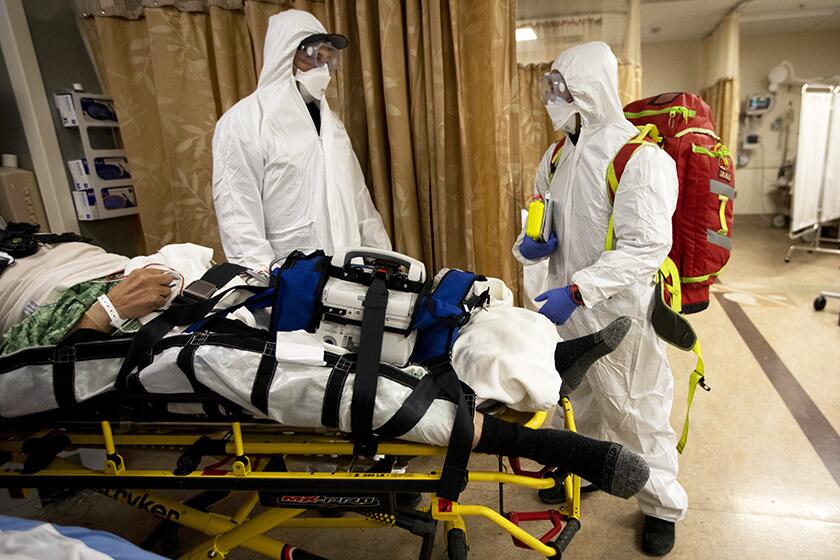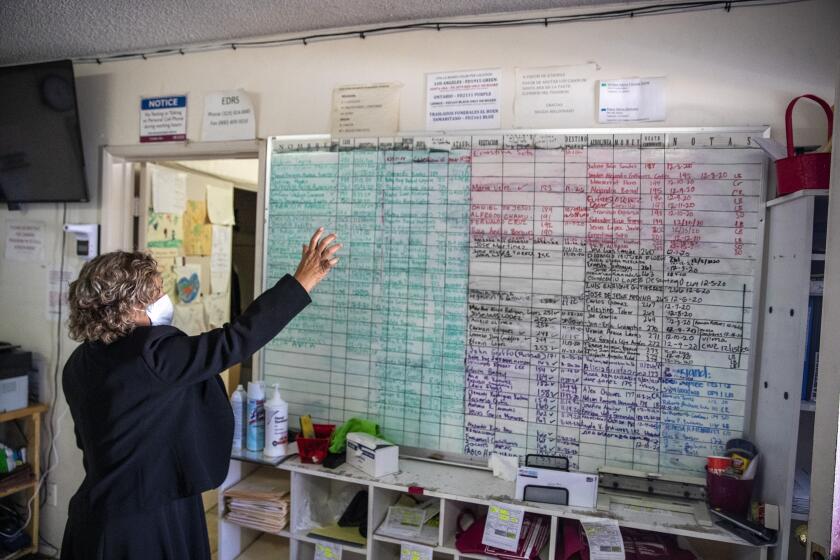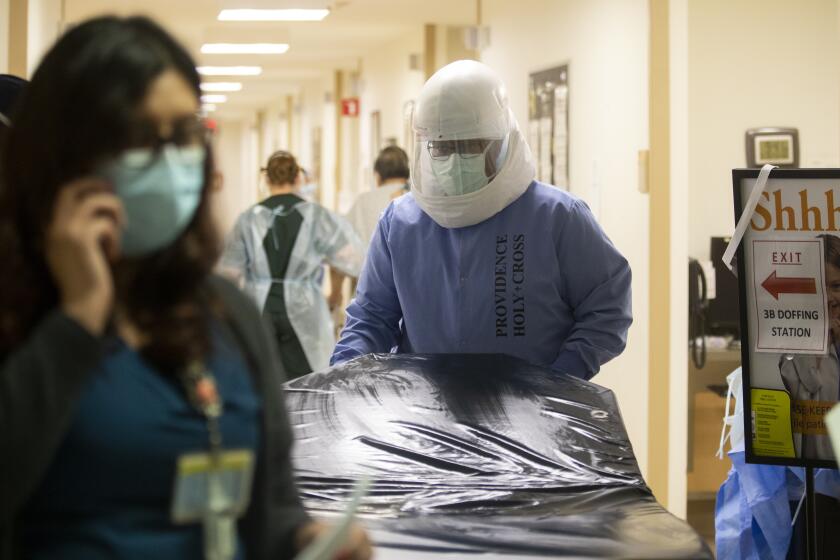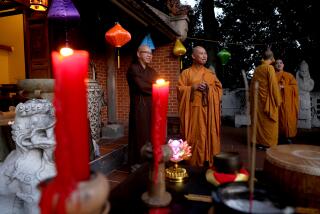Ambulance scarcity, long 911 response times: COVID pushes L.A. County to ‘brink of catastrophe’
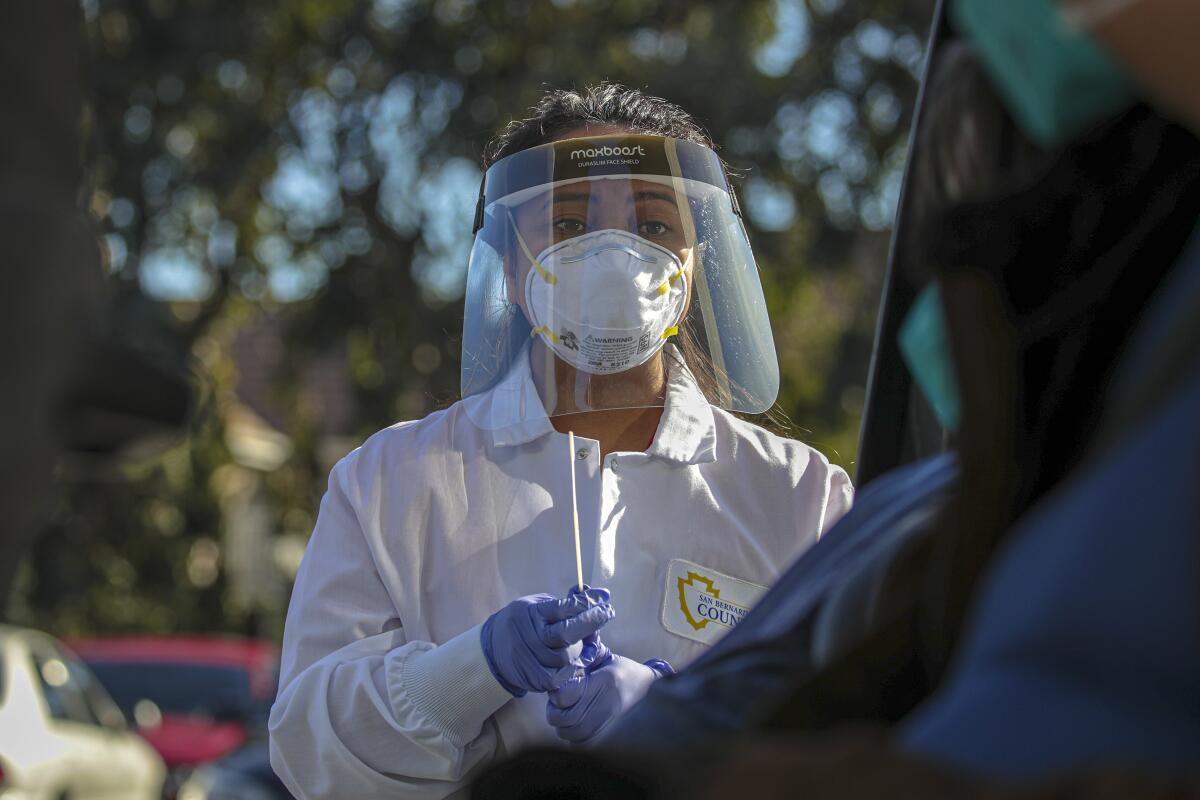
- Share via
Lengthy wait times to offload patients at Los Angeles County’s critically overcrowded hospitals are increasingly keeping ambulances from being able to respond to other emergency calls, officials said Thursday — the latest repercussion of the rampant and widespread coronavirus surge that’s walloping the region’s healthcare system.
Sometimes, as many as 10 ambulances are queued up waiting to drop off patients, and “we’ve had patients waiting in ambulance bays outside of [emergency departments] for seven hours, eight hours,” said Cathy Chidester, director of the L.A. County Emergency Medical Services Agency.
“We’re running out of ambulances, and our responses to 911 calls are getting longer and longer,” she said during a briefing Thursday.
In the Antelope Valley, “response times are getting longer,” forcing officials to begin relying on ambulance companies that are not traditionally used to respond to 911 calls, according to Chidester.
And elsewhere in the county, officials are working with fire departments to staff hospitals’ ambulance bays to help offload patients quicker so the vehicles can get back into circulation.
Unlike other cataclysms, such as a fire or an earthquake, Chidester said COVID-19’s toll on hospitals has been a “hidden disaster,” one that’s not immediately apparent to the public.
But make no mistake, she emphasized, “we are in the midst of a disaster.”
“You can see the look in the staff’s eyes. It’s like the deer in the headlights,” she said. “They’re overwhelmed. They are pale. They are trying to do the best they can with limited resources at this point because there’s so many patients.”
L.A. County hospitals hit breaking point: ‘No one would believe this is in the United States’
As the COVID-19 crisis worsens, and the number of infected individuals requiring professional care continues to balloon, some hospitals have needed hours to make room for new patients arriving by ambulance; to send staff to treat people in the ambulances themselves; or, in especially strenuous moments, to temporarily shut their doors to ambulance traffic altogether.
There have been such lengthy delays offloading patients that there have been “some unfortunate outcomes,” Dr. Christina Ghaly, the L.A. County health services director, said this week.
The effects of an overtaxed healthcare system ripple far beyond those infected with COVID-19. Officials have recently expressed concern that people suffering from strokes, heart attacks and seizures are languishing outside hospitals without receiving the timely care they urgently need.
Even those afflicted by more sudden emergencies, like getting in a car accident, may be unable to get the medical attention they need if conditions continue to deteriorate.
It’s a “very dire situation that’s facing the hospitals” Ghaly said Thursday, and “this surge is pushing all hospitals countywide to the brink of catastrophe.”
‘My mom died last night.’ A teacher lost to COVID-19, leaving a young son and so many others reeling
For an L.A. Times reporter covering the pandemic, the statistics suddenly became tragic, personal losses, family and friends taken by the virus.
Not everyone who makes it into the hospital is lucky enough to go home, however. The virus has killed more Californians on each of the last two days than any other day throughout the course of the entire pandemic — a back-to-back battering that has propelled the state’s total death toll past 25,000.
California is the third state to reach that morbid mark, joining Texas and New York.
In the last three days, more than 1,100 people statewide have died from COVID-19, including a record-high 442 Tuesday and the next-highest total, 424, on Wednesday.
Those numbers represent roughly the equivalent of one person dying from the disease every three and a half minutes.
The situation has gotten so bleak that some mortuary and funeral home operators are saying they have to turn away bereaved families because they don’t have the capacity to handle more bodies.
Southern California mortuary and funeral home operators say they are having to turn away bereaved families because they can’t handle more bodies.
In Los Angeles County, which officially surpassed 10,000 total coronavirus-related fatalities Wednesday, officials said they’re now seeing roughly 150 people dying from COVID-19 each day — a figure that’s almost as high as the average number of people dying daily from every other cause.
That equates to one Angeleno dying every 10 minutes.
Starting at midnight Thursday, county officials began posting new messages on Twitter at that interval, describing someone who may have just lost his or her battle with COVID-19: the principal who stayed late to watch every school play, an ER nurse who pulled double shifts for months on end, the local activist who labored to uplift a community, a cherished coworker or friend, a beloved family member.
Each message was punctuated with the same plea: “Slow the spread. Save a life.”
“Most heartbreaking is that, if we had done a better job reducing transmission of the virus, many of these deaths would not have happened,” L.A. County public health director Barbara Ferrer said.
The nation’s most populous county has also set consecutive records for daily COVID-19 deaths this week, with 262 reported Wednesday and 242 on Tuesday.
Though the recent numbers were partly influenced by a reporting backlog from the Christmas holiday weekend, officials say they represent a sobering reality: that some are now paying the ultimate price for decisions they or those they came into contact with made weeks ago.
“We have a chance to make it right,” Ferrer said Wednesday. “So let’s start today by recognizing our shared humanity and responsibility to take care of each other.”
County officials have been concerned about the risk of strokes, heart attacks and seizures among patient waiting in ambulances outside of hospitals
While there’s been some cautious optimism that the worst wave of the pandemic is beginning to level off in some areas — though, notably, not in Southern California — the recent record-high death tolls demonstrate the continued devastation wrought by the coronavirus and, officials warn, point to even darker days ahead if the state is slammed by another surge stemming from widespread gatherings and travel for the winter holidays.
California also must now contend with the presence of a new variant of the coronavirus that some scientists believe is even more contagious. The strain, first identified in the United Kingdom, has been detected in a 30-year-old man in San Diego County, and it’s unclear how widely it may have circulated.
“The next number of weeks will be challenging, in particular as it relates to this surge on top of a surge — I would argue on top, again, of a likely additional surge coming from Christmas and, hopefully, one that’s a little more modest from New Year’s,” Gov. Gavin Newsom said.
Everyone, he added, needs to be mindful of the dangers posed by the pandemic.
“Please don’t just assume or think or believe naively that this is something that won’t impact you because you’re younger, it’s ‘just about older people,’” he said Wednesday.
As hospitals struggle to keep up with the flood of COVID-19 patients, the state has also deployed 1,280 medical personnel — including from the California National Guard medical corps — to assist in healthcare operations, officials said Thursday.
A particularly precious resource are beds in hospitals’ intensive care units, which are needed for patients in the worst condition.
The nation’s top infectious disease expert weighs in on what 2021 might look like amid the coronavirus pandemic.
Southern California and the San Joaquin Valley have consistently had 0% available capacity in their ICUs for roughly two weeks — a distressing metric that doesn’t necessarily mean no beds are open but that space, resources and staff are being stretched precariously thin.
ICU availability had fallen to 8.5% in the Bay Area as of Thursday, according to the latest state data, and was at 14.4% in Greater Sacramento.
All four of those regions are under state stay-at-home orders, which aim to tamp down coronavirus transmission through strict limits on businesses and activities.
Though restrictions have been met with resistance in some corners, with a ban on outdoor dining proving to be particularly objectionable, officials and experts say they are girded in a fundamental truth: that the single-best way to curb the virus is to reduce opportunities for it to spread by cutting back on interactions and mingling between different households.
During a virtual conversation with Newsom on Wednesday, Dr. Anthony Fauci, the U.S. government’s top infectious diseases expert, said it’s incorrect to present the situation as a choice between public health or economic strength.
“We need to use public health measures as a vehicle, a gateway, a tool to get the economy back,” he said. “It isn’t the economy versus public health. It’s public health bridging you to getting the economy back. That’s what we’ve got to realize, and not say, ‘I don’t want to do this because I want the economy to open.’ You will open the economy when you get the level of infection down, and the only way you’re going to get the level of infection down before the vaccine kicks in is by the public health measures.”
To battle the coronavirus surge, San Francisco city officials on Thursday indefinitely extended a stay-at-home and travel restrictions.
Officials have earnestly urged residents to stay home and avoid the temptation to celebrate New Year’s with anyone they don’t live with.
San Francisco indefinitely extended its coronavirus stay-at-home and travel quarantine orders Thursday, and state officials said the order covering the Greater Sacramento region also will “likely be extended based on early ICU projections.”
All throughout the state, officials have pleaded with residents not to gather for the holiday with people outside their immediate households.
“The steps we have taken together have served us well, but the fact remains that San Francisco is in the midst of its worst surge yet,” said Dr. Grant Colfax, the city’s public health director. “We must continue to take the preventive measures that we know slow the spread of the virus and save lives.”
Should those pleas fall on deaf ears, officials warn that the turning of the calendar will bring more pain and suffering to a state already reeling from a year of incalculable loss.
“We absolutely have to get this surge under control, and it will take everyone’s effort to do so,” Ghaly said. “If we don’t, then the beginning of 2021 will be worse than the end of 2020. And that is not a situation that any of us want to have happen.”
Times staff writers Maura Dolan, Soumya Karlamangla and Matthew Ormseth contributed to this report.
More to Read
Sign up for Essential California
The most important California stories and recommendations in your inbox every morning.
You may occasionally receive promotional content from the Los Angeles Times.
